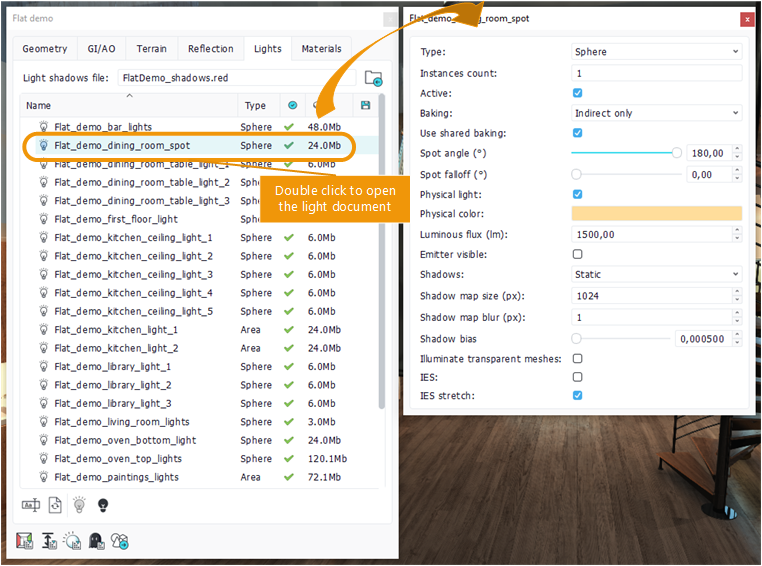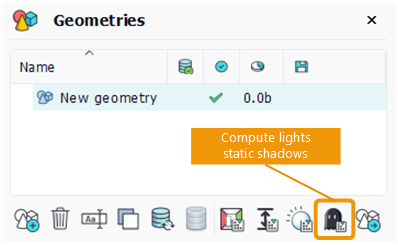Lights overview
When creating a geometry from an external source file, lights are imported as well. They can't be created from scratch yet, only modified.
The light panel
Once the geometry is loaded, the list of associated lights is available under the Lights tab. A dedicated light panel can be opened by double clicking on a list item.

Opening the light panel
The lights can be of four types:
- Point: classical centric light (non physical).
- Sphere: physical light with a finite spherical surface.
- Area: physical light with an area surface.
- Other: all other lights that are not recognized by NDunes.
Point and sphere lights can have a spot angle and falloff restraining its lighting area.
The sphere and area lights implement a physical lighting model. Their intensity is set with a luminous flux in lumens and depends on their surface area.
An option of the panel allows to Illuminate the transparent meshes (transparent parts of the geometry and plants). Deactivating this option will speed up the rendering since the forward pipeline is quite performance-hungry.
Light baking
Lights can be dynamic or baked. A dynamic light can be moved and the enlightened objects can also move dynamically. There is no indirect lighting. A baked light is precomputed. It is static and doesn't allow any movement. The direct lighting is baked as well as the indirect lighting. A third option exists: indirect only. With this option, the direct lighting is dynamic and the indirect lighting is baked.
The lights baking data are computed together with the geometry GI cache (see Adding global illumination). All the baked lights are stored in the unique GI cache file of the geometry.
Two steps to bake a light:
- flag it as baked in the light panel;
- compute the GI cache of the geometry.
Note:
Any type of light can be baked. Lights of type "Other" are only visible when baked.
An option is available to use shared baking. When activated, this option merges the lights baking data in a single structure. Its purpose is to save memory at the cost of not being able to individually turn the lights on and off.
Light shadows
Dynamic lights can have shadows via shadow maps. The shadows can be dynamic or static. Dynamic shadows are rendered at each frame whereas static shadows must be precomputed.
Note:
Currently only point light with a spot angle can have dynamic shadows.
Several properties are accessible in the light panel:
- shadow map size in pixels;
- shadow map blur in pixels;
- shadow bias.
To precompute the static shadows, click on the shadows button in the geometry toolbar. The tool will calculate the shadows of all the lights of the geometry that have been flagged as "Static".

Compute the lights static shadows
The static shadows of all the lights of the geometry are stored in a single .red file. The file location is visible on top of the Light tab of the geometry panel.
Note:
Baked lights shadows are automatically handled by the baking.
Light IES support
NDunes supports IES data for lights. If IES data is associated to the light, the IES checkbox of the light panel will be checked.
When the IES stretch property is checked, the IES data are remapped between 0 and the spot angle. Otherwise they are mapped between 0 and PI and clamped at the spot angle.
The lights with IES are automatically physical and the intensity is set with a luminous flux.
 Adding reflections Adding reflections | Materials overview |



